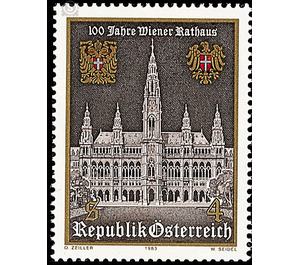100 years - Austria / II. Republic of Austria 1983 - 4 Shilling
Theme: Architecture
| Country | Austria / II. Republic of Austria |
| Issue Date | 1983 |
| Face Value | 4.00 |
| Color | brown |
| Printing Type | combination printing |
| Stamp Type | Commemorative |
| Item Type | Stamp |
| Chronological Issue Number | 1095 |
| Chronological Chapter | OOS-OE2 |
| SID | 70675 |
| In 63 Wishlists | |
The Vienna City Hall celebrated its 100th anniversary on 12 September 1983. This building was the result of major changes in Vienna in the second half of the 19th century. The young Emperor Franz Josef I wished his capital to be comparable to the great metropolises of Western Europe and, contrary to the opinion of the military, ordered the wiping of the Viennese fortifications in 1857. Thus, a union of the suburbs with Vienna spatially and urban planning was possible. In the place of the bastions, a boulevard should appear, flanked by public buildings and representative private buildings. Among other things, the creation of a "town house" was planned. From the competition drafts for this construction went the cathedral master builder of St. Stefan, Friedrich Schmidt (1825-1891) with his project as the winner. The town hall was built in the style of historicism. On May 25, 1872, the first cut of the spade took place, on June 14, the solemn laying of the foundation stone was made. The construction was completed only over ten years later. On the anniversary of the relief battle of the Turkish year 1683, on 12 September 1883, the final stone was laid. The brand motif shows the Vienna City Hall as well as the old and the new coat of arms.


